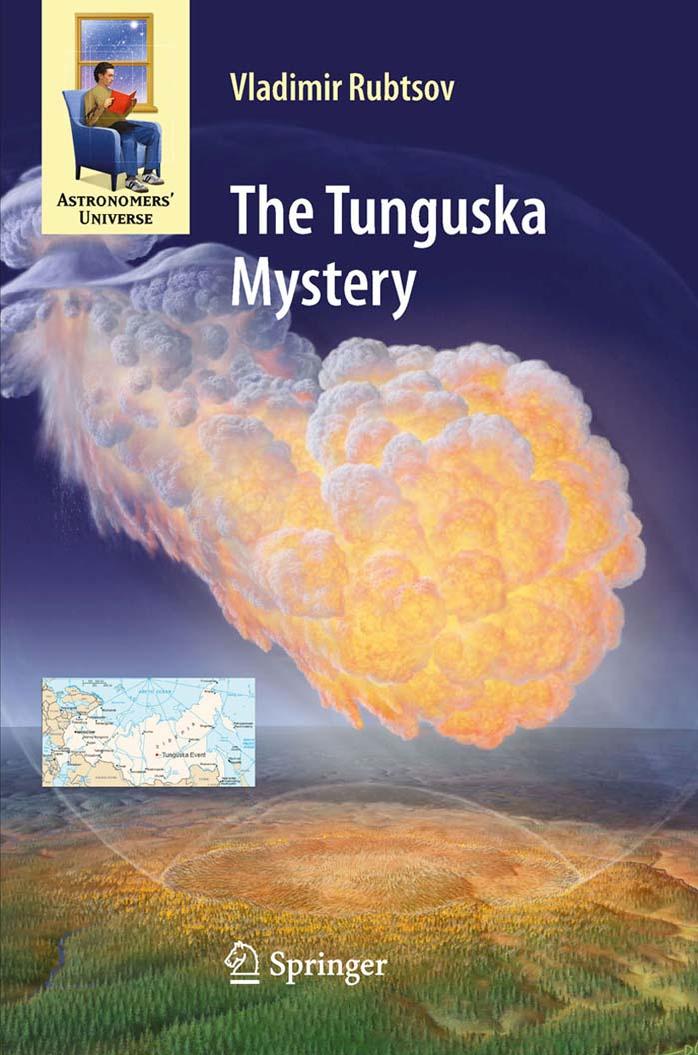The Tunguska Mystery by Vladimir Rubtsov & Edward Ashpole

Author:Vladimir Rubtsov & Edward Ashpole
Language: eng
Format: mobi, epub, azw3, pdf
Tags: Research, Astrophysics, Body, Tunguska Meteorite, UFOs & Extraterrestrials, Meteorites, Mind & Spirit, Russia (Federation), Astronomy, Siberia, Springer, ISBN-13: 9780387765730, Science, Sightings and Encounters, Physics, History, Nuclear Explosions, Technology & Engineering, Unidentified Flying Objects, Curiosities and Wonders, General, Explosions
ISBN: 9780387765730
Publisher: Springer
Published: 2008-12-01T00:00:00+00:00
duration of the effect. The TSB had exploded in the lower atmo-
sphere, at a height less than 10 km, where high-temperature plasma
can exist only several minutes before it recombines.14
168 The Tunguska Mystery
But Ivanov himself, trying to exorcize from his calculations the
evil spirit of nuclear reactions, created a very unconvincing model of
the Tunguska geomagnetic effect. He believed that it could have
been due to the thermal ionization of the ionosphere. Yes, if some
volume of the rarified air of the ionosphere (which is, of course,
already ionized by solar radiation) is heated up to the temperature
of 6,000–7,0008C it would be additionally ionized. But what could
have raised the temperature of the air so much? According to Kim
Ivanov, it was the blast wave of the Tunguska explosion that
had such a high temperature and therefore must have heated the
ionospheric air. Alexey Zolotov did, however, demonstrate – math-
ematically and by referring to direct measurements from nuclear
tests – that the Tunguska blast wave could not be so hot. In fact,
even the blast wave of a powerful thermonuclear explosion has the
temperature of 6,0008C at a distance of 1.5 km from the center of the
explosion. And its temperature decreases very swiftly with distance.
Thus, in the ionosphere the temperature of the blast wave of the
Tunguska explosion would not have exceeded 2008C – which is
absolutely insufficient for the thermal ionization.15
There is, by the way, one more reason that prevents us from
accepting the blast wave theory as a satisfactory explanation of the
Tunguska geomagnetic storm. All specialists agree that the artificial
geomagnetic effects, discovered in the nuclear tests of 1958, were
very similar to that recorded in 1908. The shapes of the curves, the
relative durations, and the amplitudes of various phases are practi-
cally the same. So, Victor Zhuravlev drew the attention of the
Tunguska research community to a very simple error that had
been made by the supporters of the blast wave hypothesis.
As it follows from the models of Ivanov’s and Kovalevsky’s,
both hard radiation and the blast wave could have led to the same
result, that is, to the local geomagnetic effects. Well, let’s accept for a while that the Tunguska explosion was not accompanied by hard
radiation and the Tunguska geomagnetic storm was produced by
nothing but its blast wave. But then, it means that after a nuclear
explosion two geomagnetic effects would have been produced. The
first generated by the hard radiation and the second by the blast
wave. Since the velocity of propagation of hard radiation exceeds
that of the blast wave by many thousands of times, the interval
between them would have been about 5 min. Why, then, did the
The Third Key
169
high-altitude nuclear explosions in the atmosphere produce only
one geomagnetic storm from the hard radiation of the fiery ball?
Where is the second from the blast wave?
Can we suppose that the blast wave of a high-altitude nuclear
explosion traveled through the ionosphere not disturbing the geo-
magnetic field, whereas the same wave from the Tunguska explo-
sion did disturb it? No, we cannot. If a blast wave could have
produced the local geomagnetic effect, the high-altitude nuclear
tests would have recorded ‘‘paired’’ geomagnetic storms – from the
hard radiation of the fiery ball and from the blast wave.
Download
The Tunguska Mystery by Vladimir Rubtsov & Edward Ashpole.epub
The Tunguska Mystery by Vladimir Rubtsov & Edward Ashpole.azw3
The Tunguska Mystery by Vladimir Rubtsov & Edward Ashpole.pdf
This site does not store any files on its server. We only index and link to content provided by other sites. Please contact the content providers to delete copyright contents if any and email us, we'll remove relevant links or contents immediately.
| Aeronautics & Astronautics | Astronomy |
| Astrophysics & Space Science | Comets, Meteors & Asteroids |
| Cosmology | Mars |
| Solar System | Star-Gazing |
| Telescopes | UFOs |
Tools of Titans by Timothy Ferriss(8218)
Turbulence by E. J. Noyes(7936)
Secrets of Antigravity Propulsion: Tesla, UFOs, and Classified Aerospace Technology by Ph.D. Paul A. Laviolette(5309)
Astrophysics for People in a Hurry by Neil DeGrasse Tyson(5130)
Room 212 by Kate Stewart(5035)
Design of Trajectory Optimization Approach for Space Maneuver Vehicle Skip Entry Problems by Runqi Chai & Al Savvaris & Antonios Tsourdos & Senchun Chai(5011)
Pale Blue Dot by Carl Sagan(4912)
The David Icke Guide to the Global Conspiracy (and how to end it) by David Icke(4625)
A Journey Through Divination and Astronomy by Publishing Pottermore(4344)
Goodbye Paradise(3726)
Apollo 8 by Jeffrey Kluger(3637)
COSMOS by Carl Sagan(3554)
Losing the Nobel Prize by Brian Keating(3498)
The Five People You Meet in Heaven by Mitch Albom(3474)
How to Read Water: Clues and Patterns from Puddles to the Sea (Natural Navigation) by Tristan Gooley(3406)
Brief Answers to the Big Questions by Stephen Hawking(3369)
How to Read Nature by Tristan Gooley(3249)
The Order of Time by Carlo Rovelli(3145)
A Brief History of Time by Stephen Hawking(2960)
